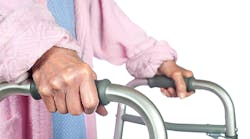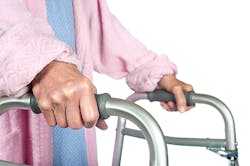BY ANNE NUGENT GUIGNON, RDH, MPH
With our aging population, we're going to face more situations where clinicians will need to accommodate patients both physically and mentally just to get the job done.
There is a profound difference between a drama queen (or king) and someone who actually can't lean back, whose neck is wracked with arthritis so badly they can't turn to the right or left, or our precious patients who can't remember what they ate for breakfast two hours ago. Factor in a plus-size patient who needs a doublewide wheel chair and can barely fit into a standard dental chair, or the post-stroke patient who can't stand independently and needs assistance to move in and out of the dental chair.
A recent discussion in an online chat group revolved around patients who could not be reclined or demanded treatment in a fully upright position. Understandably, the conversation got a bit heated. Trying to work on an upright patient is an ergonomic nightmare. There are some strategies, however, that may improve your survival and even help you reach the desired clinical outcomes.
First of all, there are patients who absolutely can't be reclined. In this case, you'll probably have to stand. Just do the best you can and document the situation in the record. For the history buffs, sit-down dentistry began 45 years ago. So for years, clinicians stood and moved around the patient chair. It can be done.
Then there are the "deceptions." Ask the doctor to come in at the beginning of the appointment. Patients rarely complain to the doctor, so use that to your advantage. Or consider pre-positioning the back before they ever walk into the room. The patient is going to assume wherever the back is positioned is the upright starting point, but you now have cleverly gained a 10- to 15-degree advantage. Or, how about claiming "back trouble" or that you won't be able to provide optimal care? Unless someone really can't recline, who would opt for less than ideal care?
About 20% of the general population suffers from back pain. Despite all of the recliner-like design features, dental chairs are built for the clinical setting and really can really aggravate back pain. Offer your patient a small pillow for lumbar support. A cylindrical pillow placed under the knees readjusts the hip/pelvis angle, relieving lower back stress. Massage pads are comforting, and the vibration is calming to many. U-shaped neck pillows provide remarkable support for those with neck tremors or osteoporosis.
Crescent Dental has a great head support pillow that reverses for the maxilla and the mandible, making it much easier to access the specific arch. Crescent also has a specific neck support designed for those with osteoporosis in their necks.
Patients with benign positional vertigo (BPPV), an inner ear condition, find it very uncomfortable to recline or reposition their head quickly. The inner ear has fluid-filled semi-circular canals, which signal your body position to the brain. BPPV occurs when free-floating calcium deposits in the inner ear send confusing messages to the brain. Patients with chronic sinusitis issues also find it uncomfortable to be put too far back.
Back to the Internet group. Members wondered how patients, who refused to be reclined, sleep in bed at night. Surprisingly, not all people actually sleep fully reclined. Some prop their heads up with multiple pillows; others use a recliner for their nighttime rest.
Dental chairs are not comfortable beds; they are devices that allow us to deliver services. They put people in vulnerable positions, feeling that they can't escape, especially with a mouth crammed full of dental instruments. Before you cast aspersions at those who do not want to be reclined, try lying down in the dental chair in your treatment room. Think about how it feels to have water collecting in the back of your throat or dribbling down your chin. Being reclined brings out the worst in those with a strong gag reflex. Is the overhead light blinding you or the noise of the suction making you tense?
So patients who refuse to be reclined are not our only challenge. Let's shift gears to those who are wheelchair-bound. While we want to be accommodating, transferring a patient from a wheel chair to a dental chair seems simple on the surface but it is a complex task, often requiring proper training and the right equipment. Most dental professionals do not have either. There are dental health care workers who have gotten hurt trying to transfer a patient.
Arrangements should be made to have a trained caregiver present, prepared to provide a safe transfer in and out of the dental chair. Medical facilities allocate significant funding for equipment and training, so that their employees can execute a safe move. We need to ensure that dental professionals follow the same type of protocols. Transferring and transporting obese patients is the top reason EMTs get injured on the job. Dental professionals do not need to add another risk factor for getting injured on the job.
A personal perspective on caring for complex patients
My patient couldn't swallow because of a stroke. He could not lay back at all and had to spit in cup. Every time I treated him, my back hurt every minute, but you do what you have to do to care for your patients. He was very appreciative and understood how hard it was on both of us. He always had a massive amount of calculus on every surface.
- online comment from Linda James, RDH, Albany, Oregon
On a bright note, DentalEZ is already ahead of the curve. Last year, they introduced the amazing Nu Simplicity chair. It is the exact patient chair I'd be angling for in my treatment room. I did a demo test of the NuSimplicity chair in the exhibit hall at the Yankee Dental Meeting last January and was blown away with how much more comfortable it was than other patient chairs. Not only does it support the patient's body well, the design minimizes physical stress to the clinician's body. The NuSimplicity is designed with a wafer-thin, narrow back, sufficient enough to support a patient but trim enough for clinicians to get in close. The arms are fully adjustable. The chair base pivots in multiple directions and a special feature makes it possible to reposition the chair to accommodate an event such as a wheel chair transfer. There are some really cool videos on the DentalEZ website.
Despite some tremendous advances in dental treatment, the mere thought of a dental visit still creates great stress and anxiety for some. I really don't think patients are trying to be difficult on purpose. Unresolved fears translate into less than ideal behavior on their end. Our response can either come across as cold and callous, further exacerbating the issues, or we can step back, take a deep breath and try to help our patients identify the source of anxiety.
Asking your doctor to participate in the conversation about dealing with patients who have mobility issues is really smart. The whole team needs to understand the limitations of the situation, the risks to your musculoskeletal health. There needs to be a clear consensus that you will provide the best care possible considering each individual situation. Circumstances, however, may dictate additional visits, billed at the appropriate fee level.
We don't need more reasons to get hurt. But as the population ages and people are living longer, dentistry will have to make changes in how we accommodate and care for people. Change is hard. It rocks our comfort zone; but if we don't change, we're going to get broken.
ANNE NUGENT GUIGNON, RDH, MPH, provides popular programs, including topics on biofilms, power driven scaling, ergonomics, hypersensitivity, and remineralization. Recipient of the 2004 Mentor of the Year Award and the 2009 ADHA Irene Newman Award, Anne has practiced clinical dental hygiene in Houston since 1971.







